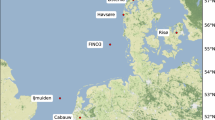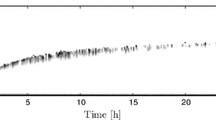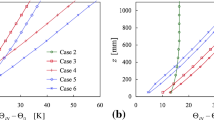Abstract
The micrometeorological research program in Antarctica has provided extensive data on wind and temperature profile structure under strong to extreme inversion conditions (Dalrymple et al., 1966; Lettau et al., 1977). The basic similarity hypotheses and limiting conditions for prediction of diabatic surface layer profiles are summarized. The model by Businger et al. (1971) for dimensionless shear and temperature gradients is revised to conform with the new results for strong stability. A novel similarity hypothesis is introduced to complete the step from shear and gradient prediction to prediction of absolute wind speed, wind energy, and temperature on the basis of prescribed external factors of surface layer structure. The physics of interactions between predicted profile ‘tilting’ and ‘curving’ are discussed and used to explain several micrometeorological paradoxes, including that of the ‘elevated minimum of air temperature’ observed occasionally near the active surface when the energy budget is of the nocturnal type.
Similar content being viewed by others
References
Arya, S. P. S. and Sundarajan, A.: 1976, ‘An Assessment of Proposed Similarity Theories for the Atmospheric Boundary Layer’, Boundary-Layer Meteorol. 10, 149–166.
Businger, J. A.: 1973, ‘Turbulent Transfer in the Atmospheric Surface Layer’, Chapter 2 in Workshop on Micrometeorology (D. A. Haugen ed.), American Meteorol. Soc., Boston, Mass.
Businger, J. A., Wyngaard, J. C., Izumi, Y., and Bradley, E. F.: 1971, ‘Flux-Profile Relationships in the Atmospheric Surface Layer’, J. Atm. Sci., 28, 181–189.
Carson, D. J. and Richards, P. J. R.: 1978, ‘Modeling Surface Turbulent Heat Fluxes in Stable Conditions’, Boundary-Layer Meteorol., 14, 67–82.
Dalrymple, P. C., Lettau, H., and Wollaston, S.: 1966, ‘South Pole Micrometeorology Program’, Studies in Antarctic Meteorology; Antarctic Research Series, Vol. 9 (M. J. Rubin, editor) American Geophysical Union, Washington, D.C., pages 13–57.
Deacon, E. L.: 1953, ‘Vertical Profiles of Mean Wind in the Surface Layer of the Atmosphere’, Geophys. Memoirs, No. 91.
DeWinkel, C.: 1979, ‘An Assessment of Wind Characteristics and Wind Energy Conversion Systems for Electric Utilities’, Inst. Envir. Studies, IES Report 104, 160 pages, University of Wisconsin, Madison, Wis.
Estoque, M. A.: 1973, ‘Numerical Modeling of the Planetary Boundary Layer’, Chapter 6, pp. 217–270 in Workshop on Micrometeorology (D. Haugen ed.) A.M.S., Boston, Mass.
Geiger, R.: 1966, The Climate near the Ground, 611 pp. Harvard Univ. Press, Cambridge, Mass.
Lettau, H.: 1939, Atmosphärische Turbulenz 283 pages, Akad. Verlag. Leipzig.
Lettau, H.: 1942, ‘Das Austausch-Paradoxon von Wilhelm Schmidt’ Annalen d. Meteorologie 69, 400.
Lettau, H.: 1949, ‘Isotropic and Non-Isotropic Turbulence in the Atmospheric Surface Layer’ Geophysical Research Papers No. 1, 1–86; AF Cambridge Research Laboratories, Cambridge, Massachusetts.
Lettau, H.: 1957, ‘Summary of Non-Dimensional Characteristics of Boundary Layer Theory’ Section 7.5, pages 337–372, in Exploring the Atmosphere's First Mile (H. Lettau and B. Davidson eds.) Vol. I, Pergamon Press, New York and London 376 pages.
Lettau, H.: 1959, ‘Wind Profile, Surface Stress and Geostrophic Drag Coefficients in the Atmospheric Surface Layer’ Adv. Geophys. 6, Academic Press, New York and London.
Lettau, H.: 1969, ‘Note on Aerodynamic Roughness Parameter Estimation on the Basis of Roughness Element Description’ J. Appl. Meteorol. 8, 828–832.
Lettau, H.: 1971, ‘Antarctic Atmosphere as a Test Tube for Meteorological Theories’ Research in the Antarctic Publ. 93, Amer. Assoc. f. Advancement of Science, Washington, D.C.
Lettau, H.: 1977, ‘Climatonomical Modeling of Temperature Response to Dust Contamination of Antarctic Snow Surfaces’ Boundary-Layer Meteorol. 12, pages 213–229.
Lettau, H. and Haugen, D. A.: 1957, ‘Wind’ Chapter 5 in Handbook of Geophysics for Air Force Designers First Ed. Geophys. Res. Directorate, Cambridge, Mass.
Lettau, H. and Lettau, K.: 1975, ‘Regional Climatonomy of Tundra and Boreal Forests in Canada’ pp. 209–221 in Climate of the Arctic G. Weller and S. Bowling, eds. University of Alaska, Fairbanks.
Lettau, H., Riordan, A., and Kuhn, M.: 1977, ‘Air Temperature and Two-Dimensional Wind Profiles in the Lowest 32 Meters as a Function of Bulk Stability’ Meteorological Studies at Plateau Station, Antarctic Research Series, Vol. 28 J. Businger, editor, American Geophysical Union, Washington, D.C., Paper No. 6, 77–91.
Moeller, F.: 1964, ‘Einige Ueberlegungen zur Frage des Abgehobenen Temperaturminimums bei Nacht’ Meteorol. Rundschau, 86–89.
Monin, A. S. and Obukhov, A. M.: 1954, ‘Basic Laws of Turbulent Mixing in the Atmosphere near the Ground’ Tr. Akad. Nauk SSSR, Geofiz. Inst. No. 24, (151) 163–187.
Neumann, J.: 1964, ‘Turbulent Convection of Turbulent Kinetic Energy in Stratified Shear Flows’ Proceedings Sixth Annual Conference on Aviation and Astronautics Feb. 1964, Tel Aviv and Haifa, Israel, 47–49.
Oke, T. R.: 1970, ‘Turbulent Transport near the Ground in Stable Conditions’ J. Appl. Meteorol. 9, 778–786.
Oke, T. R.: 1978, Boundary Layer Climates 372 pages, Methuen Publications, London.
Panofsky, H. A.: 1960, ‘An Alternative Derivation of the Diabatic Wind Profile Quart’. J. Royal Meteorol. Soc., 87, 109–110.
Schlichting, H.: 1960, Boundary Layer Theory 372 pages, Methuen Publications, London.
Schmidt, W.: 1921, ‘Wird die Luft durch Konvektion von der Erdoberfläche her erwärmt?’ Meteorol. Zeitschr. 38, p. 262.
Sellers, W. D.: 1961, ‘A Simplified Derivation of the Diabatic Wind Profile’ J. Atm. Sci. 19, 180–181.
Stearns, C. R.: 1969, ‘Surface Heat Budget of the Pampa de la Joya’ Mon. Weather Rev. 97, 860–866.
Stearns, C. R.: 1970, ‘Conversion of Profile Difference Quotients to True Gradients at the Geometric Mean Height in the Surface Layer’ Boundary-Layer Meteorol. 1, 146–154.
Yamada, T.: 1976, ‘On the Similarity Functions A, B, and C of the Planetary Boundary Layer’ J. Atm. Sci. 33, 781–793.
Author information
Authors and Affiliations
Rights and permissions
About this article
Cite this article
Lettau, H.H. Wind and temperature profile prediction for diabatic surface layers including strong inversion cases. Boundary-Layer Meteorol 17, 443–464 (1979). https://doi.org/10.1007/BF00118610
Received:
Issue Date:
DOI: https://doi.org/10.1007/BF00118610




